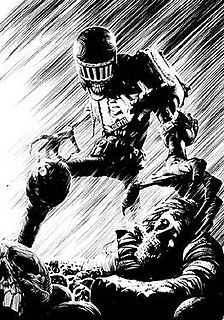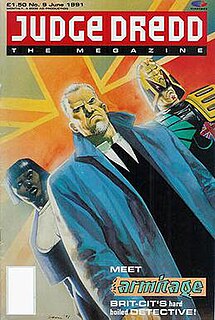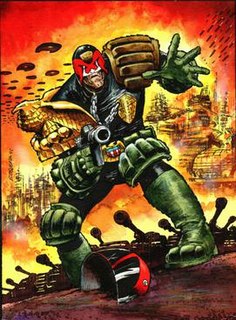Related Research Articles
Judge Dredd is a comic book franchise based on the longest-running comic strip in 2000 AD (1977), a British weekly anthology comic.

2000 AD is a weekly British science fiction-oriented comic magazine. As a comics anthology it serialises stories in each issue and was first published by IPC Magazines in 1977, the first issue dated 26 February. IPC then shifted the title to its Fleetway comics subsidiary, which was sold to Robert Maxwell in 1987 and then to Egmont UK in 1991. Fleetway continued to produce the title until 2000, when it was bought by Rebellion Developments.

Judge Death is a fictional character of the Judge Dredd stories in the UK comic 2000 AD. He is the leader of the Dark Judges, a sinister group of undead law enforcers from the alternate dimension of Deadworld, where all life has been declared a crime since only the living commit crimes. He is also the arch-enemy to Judge Dredd. After years of appearing in Judge Dredd stories, he later got his own series in the Judge Dredd Megazine and in 2000 AD.

Mega-City One is a huge fictional post-nuclear megalopolis-size megacity city-state covering much of what is now the Eastern United States and some of Canada in the Judge Dredd comic book series and its spinoff series. The exact geography of the city depends on which writer and artist has done which story, but from its first appearance it has been associated with New York City's urban sprawl; originally it was presented as a future New York, which was retconned as the centre of a "Mega-City One" in the very next story.

The Angel Gang is a fictional group of villains appearing within the Judge Dredd comic strip in the weekly comic book 2000 AD. They are "a family of scruffy, backwoodsy, outrageously cruel thugs" from the Cursed Earth near Texas City who vie with the titular Dredd. First introduced in 1980, the Angel Gang have been recurring antagonists in 2000 AD since. In addition to their appearances in 2000 AD, the Angel Gang have featured in the 1995 film Judge Dredd, videogames,, and tabletop games.

Chief Judge Barbara Hershey is a fictional character in the Judge Dredd series that appears in British comic 2000 AD. For nearly two decades she regularly appeared as Dredd's junior colleague, before being promoted to become his superior in 1999. She also had her own solo series, Judge Hershey, in the Judge Dredd Megazine (1992–1997).

Chief Judge Clarence Goodman is a fictional character in the Judge Dredd stories published in the British comic 2000 AD. He appeared in the first episode of Judge Dredd in March 1977, and was the first regularly recurring supporting character.

Devlin Waugh is a fictional character who has appeared regularly in British comic anthologies 2000 AD and Judge Dredd Megazine. The character, a homosexual vampire, was originally created by the writer-artist team John Smith and Sean Phillips in 1992. He is the first openly gay lead character in a UK comic.

Chief Judge of Mega-City One is the title of several supporting characters in the Judge Dredd comic strip published in 2000 AD. The chief judge is dictator and head of state of Mega-City One, a fictional future city of around 400 million people in 22nd-century America. The present chief judge is Judge Logan.

Chief Judge Cal is a fictional character in the Judge Dredd comic strip in 2000 AD. He was loosely based on the Roman emperor Caligula as portrayed by John Hurt in the 1976 television show I, Claudius. He was the villain in the story The Day the Law Died! (1978–79).

Judge Grice was a fictional character in the Judge Dredd comic strip in 2000 AD. Created in 1990 by John Wagner and Steve Dillon, Grice later had his own spin-off series, Purgatory (1993) by Mark Millar and Carlos Ezquerra. Originally a minor supporting character and one of Dredd's colleagues, he later became a notable villain, at first with good intentions, but later he descended into psychosis and became truly evil. In the Judge Dredd story "Inferno" (1993) he seized control of Mega-City One and proclaimed himself chief judge.

2000 AD crossovers are crossover stories appearing in British comic 2000 AD, its sister title the Judge Dredd Megazine, and other related output, such as novels, audio plays, films and role-playing games.

Judge Giant can refer to either of two fictional characters appearing in the Judge Dredd comic strip in 2000 AD. They are father and son. Their first names have never been given.

Armitage is a science fiction series appearing in the British comic anthology the Judge Dredd Megazine, created by Dave Stone and Sean Phillips in 1991. The protagonist is a Detective-Judge in Brit-Cit, a British mega-city in the universe of Judge Dredd. He has also made occasional appearances in the main Judge Dredd series in 2000 AD, as well as two spin-off novels and an audio drama.

Mechanismo is the title of a Judge Dredd story published in the British comic Judge Dredd Megazine in 1992. It was the first story in a series of stories published over the next two years in both the Judge Dredd Megazine and 2000 AD, including the epic Wilderlands. The stories concern the "Mechanismo Programme", a project to build robot Judges to police the streets of Mega-City One, and the decline of Chief Judge McGruder's authority during her last years in office. All of the stories were written by Judge Dredd creator John Wagner.
The Doomsday Scenario is the collective name of a series of Judge Dredd comic stories published in 2000 AD and the Judge Dredd Megazine in 1999. Written by John Wagner, it was the third such crossover story between those two publications, but was the first in which it was possible to read a complete and coherent tale by reading only those episodes which appeared in one comic or the other without having to buy both magazines. It was reprinted as two trade paperbacks, each collecting the episodes from one comic. When first published it was the longest Judge Dredd story arc ever told, at a total of 32 episodes and 279 pages, as well as several prequels and epilogues. The story tells of the Second Robot War in the year 2121, but its epilogues wrapped up two story arcs that had been developing for several years: former judge Galen DeMarco's unrequited love for Judge Dredd, and Dredd's bitter rivalry with Judge Edgar. The story is also notable for leading to the promotion of Judge Hershey, Dredd's sidekick and one of the strip's longest-running supporting characters, to the office of chief judge.
"Trifecta" is a Judge Dredd story arc published in British comic 2000 AD in late 2012, following on from the earlier strip Day of Chaos. The story was an unannounced crossover between Judge Dredd and its spinoff strips The Simping Detective and Low Life.

Judge Joseph Dredd is a fictional character created by writer John Wagner and artist Carlos Ezquerra. He first appeared in the second issue of 2000 AD (1977), which is a British weekly anthology comic. He is the magazine's longest-running character. He also appears in a number of film and video game adaptations.
References
- ↑ "Robot Wars," 2000 AD #10–17
- ↑ "Firebug," 2000 AD #60
- ↑ "The Sleeper," Judge Dredd Yearbook 1992
- ↑ Prog 191
- ↑ Prog 119
- ↑ "Destiny's Angels," 2000 AD #281–288
- ↑ ibid.
- ↑ "The Sleeper," Judge Dredd Yearbook 1992
- ↑ "Inferno," 2000 AD #842–853
- ↑ "Giant," Judge Dredd Megazine vol. 2 #50–52
- ↑ "Incident at Rowday Yates," 2000 AD #1169
- ↑ Judge Dredd Megazine #203
- "The A-Z of Judge Dredd," by Mike Butcher (Hamlyn, 1995). ( ISBN 978-0600584087)